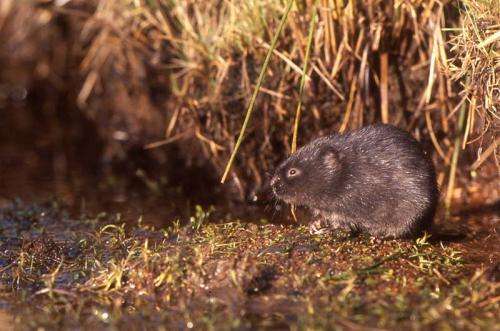Water vole on lantrine.
Young males and females can spend weeks crossing heather moors, bog lands and mountains, often putting themselves in grave danger in a bid to bag a mate. Their quest can see them embark on journeys of up to 15km from their birth place. Extraordinary for an animal not much bigger than a hamster and much further than was previously thought.
Professor Xavier Lambin, internationally recognised ecologist from the University of Aberdeen, said: "These lonely heart water voles who live in small colonies know they can't breed with their relatives and so they head off when their hormones kick in and they become unsettled because they know they have to reproduce if they are to survive.
"They will face a lot of dangers crossing unsuitable habitat to find a mate. Sometimes they get to one suitable patch and will spend three or four days there looking and waiting for a partner. If unlucky in love, they will head off again on their travels. What is amazing is that despite their small size, water voles can spend weeks and weeks covering great distances - much further than we expected - in their quest to find another water vole."
The 'dispersal' activities of these adventurous teenagers really are key to the population's survival because these 'immigrant' voles are joining or creating new colonies when others elsewhere are becoming extinct. Researchers used a variety of techniques which include DNA analysis and attaching tiny transmitters to voles living in the far north west of Scotland.
During the study, six researchers spent six weeks walking and climbing in the hills of Assynt between Lochinver and Ullapool. They discovered that the destiny of a colony is often linked to the destiny of its neighbours because of what are described as 'waves of death'. They found that if you have a big neighbouring colony that has had a catastrophe - even if those neighbours are 2 or 3 kilometres away - the chance is that you too will experience that catastrophe. As well as helping guide conservation, the researchers' findings have relevance far beyond the water vole.
"Knowledge of the way a fragmented population functions is crucial for conservation," added Professor Lambin. "Our research shows that water voles need a network of sites to survive – conserving only a single patch of land is no use."
This knowledge could prove valuable to ecologists working on the many species that have population structures similar to the water vole, from small insects to tigers.
Prof. Lambin continued, "More and more of these populations are becoming fragmented because of human activities, and some are close to their tipping point. In order to protect them we need to know more about the birth and death of these populations. We have gained a new understanding of the ability of populations to survive in fragmented habitats. And we have improved understanding of the dynamics of a charismatic, much loved but endangered species in the UK."
Provided by University of Aberdeen






















